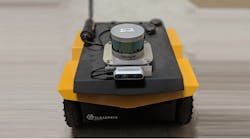Robotic systems are learning to take on a growing number of tasks from the U.S. Army, by watching humans. Researchers at the U.S. Army Combat Capabilities Development Command’s Army Research Laboratory (ARL) and the University of Texas at Austin have developed an algorithm that allows an autonomous ground vehicle (AGV) to improve its navigation systems by watching human’s drive. The algorithm, known as the adaptive planner parameter learning from demonstration (APPLD), is being demonstrated on several experimental Army AGVs with the goal that the machines may one day outdrive their human teachers.
The new learning technique merges novel machine-learning (ML) algorithms with classical autonomous navigation systems. “Using approaches like APPLD, current soldiers in existing training facilities will be able to contribute to improvements in autonomous systems simply by operating their vehicles as normal,” said Army researcher Dr. Garrett Warnell. “Techniques like these will be an important contribution to the Army’s plans to design and field next-generation combat vehicles that are equipped to navigate autonomously in off-road deployment environments.”
The APPLD technique teaches a robot (see figure) to behave more like its human teaching while still retaining the benefits of classical navigation systems. Warnell compared it to an Xbox gaming system: “A single demonstration of human driving, provided using an everyday Xbox wireless controller, allowed APPLD to learn how to tune the vehicle’s existing autonomous navigation system differently depending on the particular local environment.” He added: “For example, when in a tight corridor, the human driver slowed down and drove carefully. After observing this behavior, the autonomous system learned to also reduce its maximum speed and increase its computation budget in similar environments. This ultimately allowed the vehicle to successfully navigate autonomously in other tight corridors where it had previously failed.” The research is part of the Army's Open Campus initiative, through which Army scientists in Texas collaborate with academic partners at UT Austin. The project seeks to reduce the constant system retuning of AGVs for each redeployment, allowing the robotic systems to return themselves.
